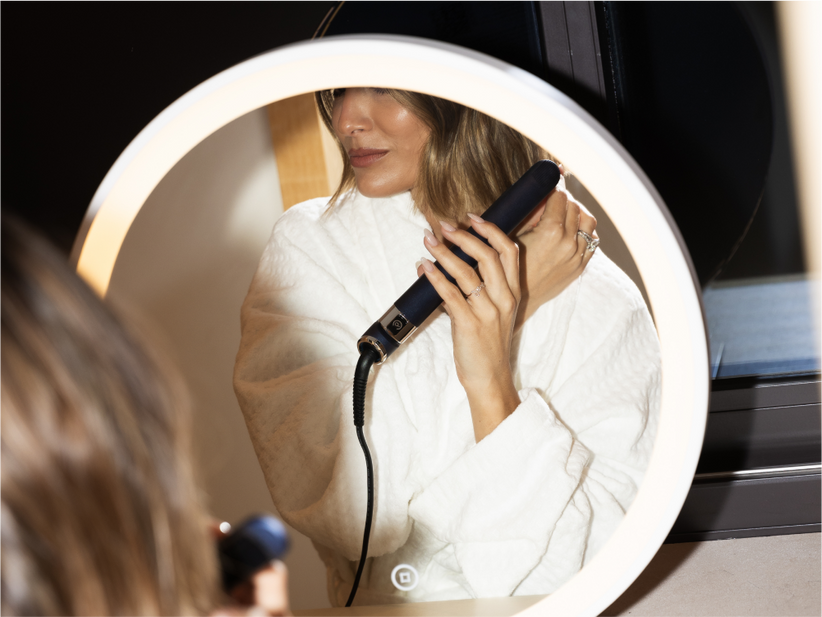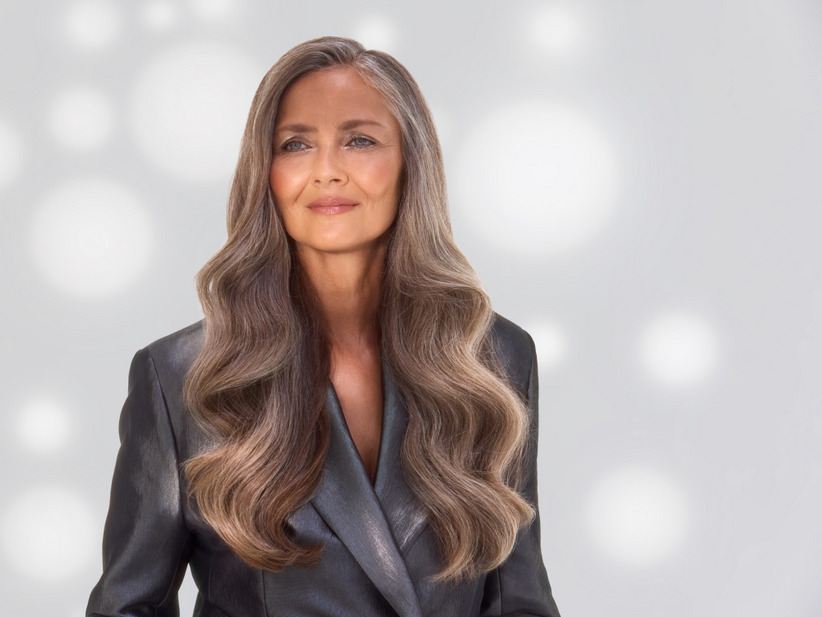Stress
Shedding hair is common after physical or emotional trauma such as childbirth or a very stressful incident like an accident or loss. Luckily, this effect is not permanent. Hair loss from stress is caused by an excess of the stress hormone, cortisol. Effective stress management can help to bring your cortisol levels back down to normal, and the hair loss you experienced should stop. If stress is the cause of hair loss, the most important advice you can give to your client is to take care of their body and mind to restore their hormone balance.
Polycystic Ovary Syndrome (PCOS)
The reproductive condition PCOS is the most common cause of high testosterone in women. While testosterone is essential in the female body in small amounts, when there is an imbalance, it can cause hair loss on the scalp, and excessive hair growth elsewhere on the body. Hair thinning is often one of the earliest signs of PCOS and is known as androgenetic alopecia.
RECOGNISING THE SIGNS OF HORMONAL HAIR LOSS
As a professional stylist, you are uniquely positioned to identify hormonal hair loss in your clients.
As hair thinning is a gradual process, most people lose over 15% of their hair’s volume before they notice a problem. With regular appointments and an expert eye, you’ll likely pick up on things that the person in the chair misses when carrying out their daily haircare routines.
How to spot hair loss
Not all hormonal hair loss appears the same. Careful observation can be the key to helping your client get to the root of their problem so they can get back on the road to regrowth as quickly as possible.
Common symptoms of hormonal hair loss to look out for include:
- Receding at the parting – In women experiencing hair loss, this is the most common pattern for hair loss or thinning. In men, a receding hairline is more common. Look out for your client’s parting appearing wider than usual.
- Loss or thinning at the temple – Gradual thinning between the forehead and ear is more typical of male pattern baldness and creates the signature V-shape we associate with a receding hairline. It’s rarer amongst women, but still possible. Check if your client has sparseness or bald patches around their temples.
- Loss or thinning at the crown – Gradual thinning at the crown is common with both male and female pattern baldness. Sudden thinning or loss in this area could have other causes, such as hormonal hair loss. Keep an eye out for increased scalp visibility when looking down at your client’s head from above.
- Bald spots and patches – Hair falling out in circular spots or patches on the scalp, in the eyebrows and (in men) the beard are common symptoms of hormonal changes as well as certain medications and conditions. These patches are usually very noticeable by moving the hair around.
- Sudden hair loss – When an emotional or physical shock triggers the sudden hormone change that triggers hair loss, this can be accompanied by a burning or stinging before the hair falls. Other than this, sudden stress-induced hair loss is very hard to predict. With this kind of hair loss, handfuls of hair will come out when tugged gently.
- Hair breakage – As already explained, while hair breakage isn’t the same as hair loss, it can appear similar and be just as distressing for the sufferer. As breakage tends to occur close to the scalp, this usually appears as patches of very short, wispy-looking hair. Elsewhere, the hair may simply seem to not grow as long or fast as it used to.
- Scalp inflammation – Just like the skin elsewhere on the body, a spike in stress hormones can irritate and inflame the scalp, giving a look of redness and irritation that may accompany hair loss.
Not all hair loss is hormonal in its cause. Some kinds of balding and thinning are caused by medical conditions, infections, medication side effects or genetics. Always communicate with your client to rule out other obvious causes of hair loss before advising that they could be suffering from a hormonal problem.
Hair loss: male and female differences
Men and women tend to lose hair in different patterns.
While the typical receding hairline and balding crown are most common in men, and usually caused by a combination of genetics and hormones, in women, the hair loss journey tends to look like:
- Diffuse thinning or balding – Hair is lost in a spread-out manner, with more focus on the crown of the head and the temples.
- Regaining hair density over time – Through a series of lifestyle changes and by taking care of the hair, health and wellbeing, many women can gain back the hair density they have lost through hormonal hair loss.
- Rarely going bald – It is unlikely that female hormonal hair loss will result in complete baldness.
APPROACHING THE CONVERSATION ABOUT HORMONAL HAIR LOSS
Sensitivity is key when opening up conversations about hair loss and thinning. Make your salon a supportive and non-judgemental environment so your clients feel safe to discuss their concerns with you.
Empowering your clients
Thankfully, self-care has become a common topic of discussion over the past few years, driven by everything from the destigmatisation of mental health to social media trends.
As a hairdresser, you’re probably pretty experienced with putting the world to rights. Many clients like to get things off their chest while they’re sitting in the salon chair, so you probably have a pretty strong relationship with your most loyal clients. When it comes to discussing hair loss, this makes you the perfect supporter – you’ve got both the expertise and the familiarity to provide reassurance to someone going through a difficult time with their hair.
While many people are becoming more comfortable talking about their health and well-being concerns, topics like hair loss can still be sensitive and emotionally challenging to discuss.
Make your client feel comfortable:
Ask questions about how they feel
Everyone responds differently to hair loss. While many people take a great hit to their confidence, this may be accompanied by other unique worries. When your client is ready to talk, ask them plenty of questions about their emotions, priorities and experiences so far so you can get a strong idea of what they want out of their appointment.
Encourage them to ask questions
Be an open book. Coming to the hairdressers can be a little intimidating for people who know little about hair. Hairdressers seem to work a kind of magic that mere mortals could never dream of understanding. But as a professional stylist, you know this isn’t really the case – it’s all in the skills and knowledge. Make it clear to your clients that you’re here to share that, and they’re welcome to ask anything they need to.
Demonstrate empathy
It’s hard enough to talk about something that’s getting you down without being met with awkwardness, or worse, silence. Talking about sensitive subjects is hard for everyone, and a kind word goes a long way. Show your clients you understand what they’re going through, and reassure them that they aren’t alone. Hair loss is common, but it can be isolating. Be a friend as well as a professional.
Make covering up an option
Not everyone is ready to embrace their hair loss and rock it with confidence while they travel the road to recovery. Some of your clients will be looking for ways to hide their bald spots and thinning areas. Help them out by offering hairstyles that conceal problem areas, or telling them about solutions such as wigs, hair extensions and scarves which cover up hair loss while they build their confidence back up.
Stick around for the long-term
Recovering from hair loss can take months if not years. Encourage your clients to book regular appointments to keep their hair and scalp on the path to recovery. The hair’s needs change as it thins and falls out and then recovers, so your clients must have you by their side throughout their whole journey.
EDUCATING YOUR CLIENTS
Hair thinning, loss and regrowth is a learning experience as well as an emotional one. When your client comes to you with questions about hormonal hair loss, make sure you can point them in the right direction.
Myth-busting hormonal hair loss
What’s the first thing you usually do when you’re worried about your health? For many of us, it’s turn straight to the internet for answers. Unfortunately, we find as many health and wellness myths online as we do useful information.
If your client has been worried about hair loss for a while, they might have already done their research and come across some myths and misconceptions in the process. Here are some common ones to dispel:
- Hair loss is always genetic
Some people are more genetically predisposed to hair loss, but there are a range of factors that impact whether you will experience thinning or loss of hair in your lifetime.
- Hair loss cannot be reversed
Many kinds of hair loss can be reversed with the right treatments, including many cases of hormonal hair loss.
- Hair loss is a male problem
Hair loss amongst women is common, especially during periods of hormonal fluctuation such as pregnancy, the post-partum period, peri-menopause and menopause.
- Hair loss is caused by washing your hair too often
Washing your hair often is not a direct cause of hair loss. In fact, keeping your scalp clean and clear of dust, dirt, bacteria and oils is essential for hair health.
Resources about hormonal hair loss
Once you’ve separated fact from fiction, it’s a good idea to provide your clients with some reliable resources so they can continue further research with confidence. The following websites and blogs are expert-led and scientifically informed:
- Alopecia UK – Offers access to in-person support groups and online forums where your client can talk to other people who are also suffering from hair loss, as well as advice, tips, and the latest research into hair loss.
- NHS – Advice and guidance about hair loss and the treatments that are available through your GP.
- Harvard Medical School – The latest research into hair loss and its causes by one of the world’s leading institutions.
- The CLOUD NINE Blog – Hormonal Hair Loss: Understanding Causes, Treatments, and Prevention Strategies
RECOMMENDATIONS FOR CLIENTS
While you’re a hair expert, it’s unlikely you’re medically trained. Therefore, you’re not qualified to diagnose or treat anyone for medical conditions that may be causing hair loss.
The NHS advises that anyone worried about their hair loss should make an appointment with their GP to talk about it and rule out the rarer, but more serious causes. If you have a concerned client, point them in this direction rather than suggesting the myriad of possible causes yourself.
GPs can help to provide those suffering from hair loss with access to counselling resources if it is causing them distress, and refer patients to a specialist trichologist if necessary.
Treatment options
The majority of hormonal hair loss is either temporary and can be expected to grow back, or a normal part of the ageing process.
While hair loss treatments do exist, they’re not always appropriate for hormonal hair loss, and none are 100% effective.
The good news is that hormonal hair loss is usually temporary and reversible. Once the hormonal balance is restored – either naturally over time or through lifestyle changes – the hair should return to its normal thickness and growth pattern.
The following treatments may be recommended to your clients either via the NHS or private healthcare providers and specialist clinics.
Hormone therapy
Hormone therapy is a common treatment for the symptoms of menopause. It uses a course of HRT (Hormone Replacement Therapy) to balance hormonal levels in the body and reduce uncomfortable and undesirable symptoms which can include hot flushes, difficulty sleeping, weight gain, and of course, hair loss or thinning. HRT is only suitable for some people and requires the supervision of a medical professional who will perform in-depth testing to ensure it’s the right option.
Medications
There are numerous hair loss medications on the market. Some work by blocking the production of DHT (dihydrotestosterone), the hormone responsible for hair loss and thinning. Again, these medications are only suitable for some people, so your clients will have to consult their doctor if they wish to pursue this treatment route.
Lifestyle adjustments
Whether alongside medical hair loss treatments or on its own, certain lifestyle adjustments can also alleviate hair thinning. These include:
- Regular exercise – To increase scalp blood flow, stimulate hair growth and balance hormones.
- Effective stress management – To lower the production of cortisol, one of the hormones linked to hair loss.
- A balanced and nutritious diet – To provide your body with the fuel it needs to function well – including creating the right balance of hormones.
As these are things everyone should be doing to improve their general health, there’s no harm in suggesting them to your clients.
Tips for your Clients’ hormonal hair
While you may not be able to prevent hormonal hair loss since it is a natural result of the body’s ageing process and the reproductive system’s cycles, you can offer your clients advice on how to manage the effects on their hair.
1. Embrace change
Accepting hair loss or thinning is easier said than done. Many of us tie a big part of our identity to our hair, so embracing a change in its condition is tough. However, accepting the evolution of your hair is essential to ensuring you can continue offering it the care it needs to keep on thriving. In the case of reversible hormonal hair loss, the faster your client accepts the problem, the faster they can put a plan in place to speed up regrowth.
2. Detox your hair
When you notice a problem with your hair or scalp but aren’t sure of the cause, a detox is the perfect way to take things back to basics and reset your hair on the path back to vitality. A detox could help to rule out things like allergic reactions to hair products and poor diet as the cause of hair thinning or loss. From cleansing to hydrating, the CLOUD NINE 9-Day Detox is a step-by-step journey, guided by our hair wellness expert, Mathilde Heather, designed to help anyone get their hair confidence back.
3. Vary the temperature
Hormonal changes can make the hair brittle and breakable at some points in life, and luscious and strong at others. That’s why it’s important to have tools that can adapt to your hair’s needs. All our CLOUD NINE straighteners have Variable Temperature Control, so you can set the heat that keeps your hair healthiest, whatever your hormones are doing. To keep up with your hair’s changing condition, use our Temperature Calculator regularly.
“A lot of media around menopause hair thinning tells women to stop heat styling, which is not what you want to hear at all when your confidence is low, your body and hair are changing, and you want to take control of your style with heated tools. Lower temperatures and tools with vibration mode are essential to ensuring you can continue to feel your best, without risking harming your hair.” – Marie Nieuwoudt, CLOUD NINE Hair Educator
4. Protect before styling
Regardless of age, life stage and hormonal needs, everyone should apply a heat protectant spray before using heated tools. Hormonal hair, being especially brittle and weak, requires extra care and hydration to keep it looking and feeling its best, and to avoid preventable hair loss and breakage. Invest in our CLOUD NINE Magical Duo for the perfect combination of moisture and protection.
5. Feed your hair from the inside
Diet is one of the most overlooked aspects of hormonal haircare. Hair-healthy nutrients like biotin, B Vitamins and omega-3 fatty acids are essential to maintaining your hair’s condition throughout your life. Ensuring your diet is varied and nutritious and you stay hydrated by drinking plenty of water can lower your chances of experiencing hair loss, as well as aiding regrowth if it does happen.
BUILDING CLIENT TRUST
Your client’s trust is the most valuable thing you can earn. With open communication, a proactive approach and personalised care, you can play a vital role in their road to recovery from hair loss. With the right support and guidance, you’ll earn the honour of being their hairdresser for life.
“As a hairdresser, you look after your clients at every stage of their life – from puberty to pregnancy, to menopause – the needs of the hair change throughout it all. I always make sure to reassure my clients that their hair is riding the hormone highway with them, and they should trust their hairdresser’s advice, and take the time to reevaluate their haircare routine at each life stage. What worked for you in your 20s might not necessarily be best for your hair in your 40s, 50s and beyond” – Marie Nieuwoudt, CLOUD NINE Hair Educator.
Next time one of your patients is suffering from hair loss or thinning, try some of the tips from this guide.
Discover more about hair loss with our other guide, Hormonal Hair Loss: Understanding Causes, Treatments, and Prevention Strategies.
Follow us on Instagram for more expert hair advice, tips, and styling content.
Join our professional community for exclusive discounts and tool registration.















.jpg?v=1689753360732)




















































